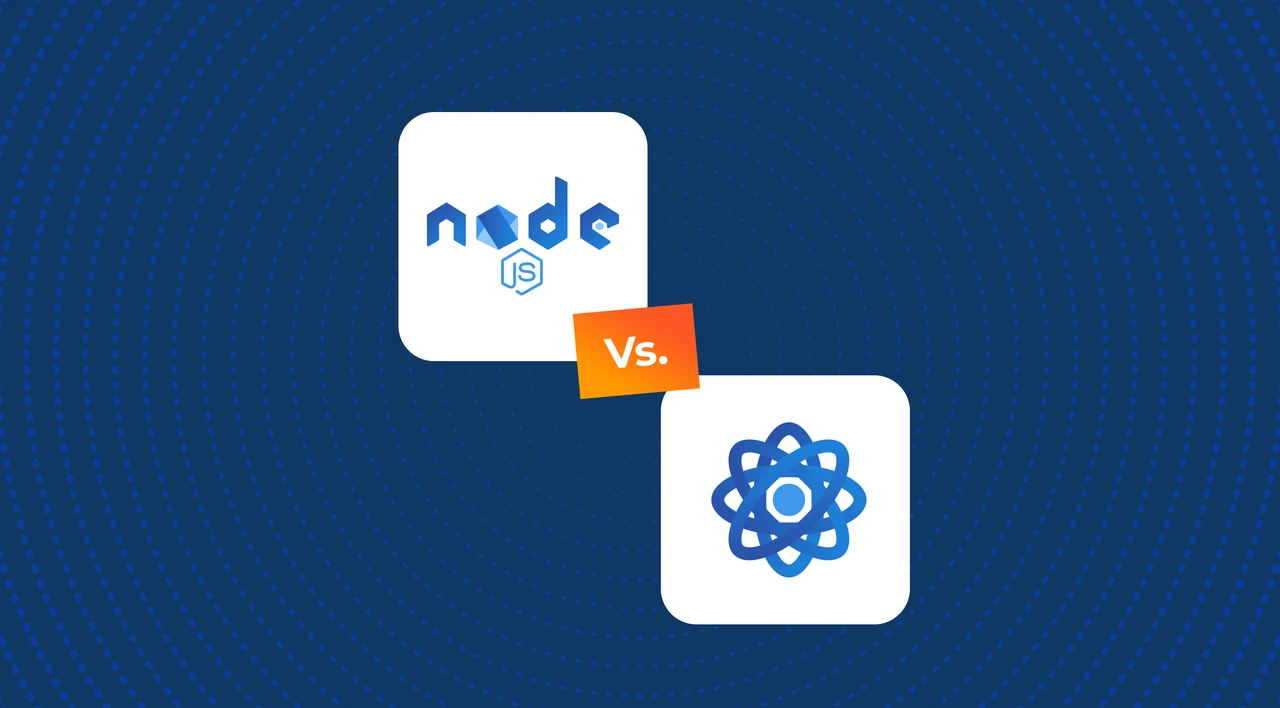SHARE
Node.js vs React: Key Differences Explored

Contents
Contents
In 2023, JavaScript was the most used programming language, used by 63% of developers. Node.js and React are both JavaScript technologies, each serving different purposes in web development. Node.js is a backend framework used for building server-side applications, while React is a front-end library specializing in creating user interfaces.
Understanding the distinctions between Node.js and React is crucial in choosing the right tool for your project. While both technologies contribute to fast and reliable web development, they excel in different areas.
This article will cover key features and benefits, use cases for each technology, a detailed comparison of their strengths and weaknesses, and guidance on how to choose the right tool for your specific project needs.
By the end, you’ll have a comprehensive understanding of when to use Node.js or React, empowering you to make informed decisions in your web development endeavors.
Key Takeaways:
- Node.js is a backend framework for server-side applications, known for its efficient and lightweight nature.
- React is a front-end library for creating user interfaces, excelling at building reusable UI components and rendering them efficiently.
- Node.js is commonly used for accessing databases, hosting APIs, and serving HTTP requests.
- Choosing between Node.js and React depends on the specific requirements of your project.
Features and Benefits of Node.js
When it comes to backend development, Node.js offers a wide range of features and benefits that make it a preferred choice for developers. It is used by more than 6.3 million websites in the US including Netflix and PayPal.
Powered by the V8 JavaScript engine, Node.js provides a runtime environment for executing JavaScript code outside of the browser, bringing the power of JavaScript to server-side development.
One of the key advantages of Node.js development is its scalability. With its event-driven and non-blocking architecture, Node.js can handle a large number of concurrent connections without the need to manage thread concurrency. This makes it highly efficient and capable of delivering high-performance web applications.
Node.js is an open-source platform, which means it is freely available and has a large community of developers contributing to its growth. This open nature has resulted in a vast ecosystem of libraries and modules, making it easy to find solutions for various development needs. Whether you need to work with databases, host APIs, or serve HTTP requests, there is likely a Node.js module available to simplify your task.
Another significant advantage of Node.js is its support for asynchronous programming. By leveraging the event-driven model, Node.js enables non-blocking I/O operations, allowing your applications to handle multiple requests simultaneously. This asynchronous nature improves the overall performance and responsiveness of your web applications.
Furthermore, Node.js offers seamless integration throughout the entire development stack. Since both the client-side and server-side are written in JavaScript, you can share code between them, reducing duplication and streamlining your development process. This flexibility and compatibility make Node.js a favored choice for building full-stack applications.
In summary, Node.js provides a powerful runtime environment, scalability, a rich ecosystem of libraries, and support for asynchronous programming. These features and benefits make it an ideal choice for backend development, enabling developers to build high-performance, scalable, and efficient web applications.
Features and Benefits of React
React.js was the most popular frontend framework in 2023, with 40% market share. React.js is a powerful front-end library that excels at building user interfaces. It provides a range of features and benefits that make it a popular choice among developers.
Virtual DOM for Improved Performance
One of the key features of React is its use of a virtual DOM algorithm. This allows React to efficiently update component states or props without reloading the entire page. As a result, React offers faster rendering and improved performance compared to traditional web development approaches.
Reusable UI Components
React allows developers to create reusable UI components, which can be leveraged across different parts of an application. This reusability not only saves development time but also makes it easier to maintain and update the application’s codebase. With React, you can build a library of custom UI components that can be easily integrated into your projects.
Unidirectional Data Flow
React follows a unidirectional data flow, which helps to improve code stability and ensure better performance. The unidirectional flow of data means that changes in the application’s state are predictable and easier to debug. This design principle also helps in creating scalable and maintainable codebases.
Compatibility with Mobile Operating Systems
React is compatible with both Android and iOS mobile operating systems, making it an ideal choice for building mobile applications. With React Native, a framework built on top of React, developers can create native mobile apps using JavaScript. This provides a seamless development experience for cross-platform applications.
High Performance and Scalability
React is widely used in complex web applications where high performance is crucial. Its efficient rendering process, combined with the ability to handle large amounts of data, makes it suitable for applications with high traffic or real-time updates. React’s modular approach allows for the implementation of optimized code, resulting in faster and more responsive applications.
Use Cases and Applications of Node.js and React
Node.js and React are versatile technologies with a wide range of applications in web development. In 2023, Node.js overtook React.js as the most used web framework. 42.7 percent of surveyed developers reported to be using Node.js, while 40.6 percent were using React.js.
Let’s explore how each of them can be used to create various types of web and mobile applications:
Node.js Use Cases
Node.js is commonly utilized for:
- Building server-side web applications
- Creating web apps and mobile apps
- Developing scalable streaming platforms like Netflix and Uber
- Hosting APIs for seamless communication between the front-end and back-end
- Powering back-end operations in full-stack applications
Node.js provides a powerful back-end framework for handling concurrent connections and efficiently processing data. It is ideal for building server-side web applications that require high performance and scalability. Additionally, Node.js can be used in combination with other front-end frameworks and libraries to create full-stack applications.
React Use Cases
React is commonly utilized for:
- Building user interfaces in web applications
- Creating dynamic and interactive UI components
- Developing mobile applications that are compatible with both Android and iOS
- Enhancing the performance and user experience of content-based applications
React is widely employed in web and mobile applications, especially in content-based platforms like Facebook, Instagram, and Twitter. It allows developers to efficiently render dynamic elements of the user interface, providing a seamless and visually appealing experience for users.
React’s modular approach and compatibility with mobile operating systems make it an excellent choice for creating engaging and responsive applications.
Combining Node.js and React allows developers to leverage the strengths of both technologies to create powerful full-stack applications. Node.js handles the back-end logic and APIs, while React powers the front-end user interface, resulting in a complete and scalable web or mobile application.
|
Node.js Use Cases |
React Use Cases |
|
Building server-side web applications |
Building user interfaces in web applications |
|
Creating web apps and mobile apps |
Creating dynamic and interactive UI components |
|
Developing scalable streaming platforms |
Developing mobile applications compatible with Android and iOS |
|
Hosting APIs for seamless communication between front-end and back-end |
Enhancing performance and user experience in content-based applications |
|
Powering back-end operations in full-stack applications |
Conclusion
In conclusion, Node.js and React offer powerful solutions for web development but serve different purposes. Node.js is an efficient backend framework ideal for server-side operations, while React is a front-end library designed for building reusable and efficient user interfaces.
When deciding between Node.js and React, consider their strengths and use cases. Node.js excels in scalability, asynchronous programming, and a rich ecosystem of libraries, making it perfect for server-side development. React provides high-performance rendering, reusable UI components, and compatibility with mobile operating systems, making it ideal for front-end development.
Ultimately, the choice between Node.js and React depends on your project requirements. Evaluate the pros and cons of each to determine which aligns best with your needs. Both technologies offer unique advantages for creating robust and interactive web applications.
Discover how Flatirons’ Node.js development services can help you create powerful and scalable server-side applications, seamlessly integrating with front-end technologies for your next JavaScript project.
Frequently Asked Questions
What is the difference between Node.js and React?
Node.js is a backend framework used for building server-side applications, while React is a front-end library used for creating user interfaces.
What are the features and benefits of Node.js?
Node.js is powered by the V8 engine, provides a runtime environment for executing JavaScript code outside of the browser, supports asynchronous programming, offers scalability and high performance, and has a large ecosystem of libraries.
What are the features and benefits of React?
React uses a virtual DOM algorithm for efficient rendering, allows developers to create reusable UI components, follows a unidirectional data flow, and is widely used in content-based applications, providing a rich user experience and compatibility with mobile operating systems.
What are the use cases and applications of Node.js and React?
Node.js is commonly used for building server-side web applications, hosting APIs, and creating scalable streaming platforms. React is used for building user interfaces in web and mobile applications, and it is often combined with Node.js for full-stack development.
Custom Software Development Services
Flatirons Development offers custom development services tailored for your unique business needs.
Get the CEO's Take
Handpicked tech insights and trends from our CEO.
Custom Software Development Services
Flatirons Development offers custom development services tailored for your unique business needs.
Get the CEO's Take
Handpicked tech insights and trends from our CEO.

Enterprise Computing: Transforming Business Operations
Flatirons
Oct 09, 2025
Explore the Top Embedded Systems Examples of Today
Flatirons
Oct 04, 2025
Best Manual Testing Tools to Boost Your Software Quality
Flatirons
Sep 28, 2025
Digital Product Development: Enhance Your Business Offerings
Flatirons
Sep 12, 2025
React SEO: Optimize Your React Apps for Search Engines
Flatirons
Sep 07, 2025
Will Software Engineers Be Replaced by AI?
Flatirons
Aug 31, 2025